Part 26
A Four-Method Analysis of the Final Period of the Great Renaissance EraAside posted:
Note this. In the following post, I list the techs in the order I researched them, and in the asides, I try to explain why I chose those techs in that order. Because I didn't take good notes, the dates for research are made up for the playthrough, and don't represent the actual research dates. Each one took me about 4 to 5 turns maximum at 50% science. That's a good measure of how fast I teched at this point.
The Great Renaissance is generally divided into four periods: The Early Period, the Changing Century, the Late Period, and the Final Period. These periods are separated by key events. Here is a short timeline:
- 1200 AD -- Denaturalists found the University of Moscow.
- 1200 AD through 1250 AD -- The Early Renaissance Period
- 1253 AD -- Lord Riv contracts tuberculosis, marking the beginning of the epidemic.
- 1250 AD through 1350 AD -- The Changing Century
- 1350 AD -- Lenin exiles the liberal leadership.
- 1351 AD through 1478 AD -- The Late Renaissance Period
- 1478 AD through 1481 AD -- The Russo-Spanish War (Now called the Three Year War.)
- 1481 AD through 1581 AD -- The Final Renaissance Period
- 1582 AD -- Russangxi Nationalists dismantle the Russian Civil Service.
Part III: A Technological Analysis of the Final Renaissance Period
by Reas Lun

I'm very pleased. The MSJ honoured me with an invitation to write this week's history file. I can think of several others, mostly friends of my husband, who are better acquainted with the Great Renaissance, but when the offer comes, I cannot refuse. I enjoy writing, and I enjoy reading. I am a merchant of stories, buying them with my ears, polishing them with words, and selling them to readers. The stories of the Great Renaissance--the stories of humans, hopes, and new machines--are more valuable to me than gold bullion. In turn, they are of great value to you. The wisest men see an invention as both itself and the scaffolding of history on which it was built. Surely, you read MSJ because you want to be a wise man.
Before we descend into the past, let's prepare ourselves for the journey. There is something we must understand. The world of the Great Renaissance was much smaller. Even though it was an age of trade and immigration, the average person never traveled more than a hundred kilometers from home. Inside such tiny, static boundaries, it was hard for the average mind to stretch and grow. International politics, technological progress, and sociological shifts: these were meaningless words. Unless a man was literate, he only had one indicator of change. When he went to market, the merchants brought him better products at cheaper prices. Beyond that, he was personally blind. Only the course of a lifetime, the contrast of then and now, could help him sense the differences.
Today, I have the benefit of literacy, education, and hindsight. Though I am not their equal, I can join the brilliant men of the Great Renaissance. I can stand beside them, above the petty geographical limitations, and I can see their influence. At this level of awareness, I can understand why technology was made, and what purpose it served for society. I hope that in the course of this essay, I pick you up and set you beside me, so that we can appreciate the same vista.
An Age of Academies
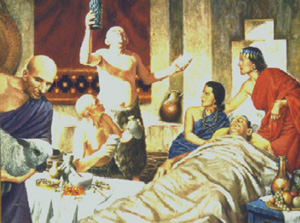
The Tutelage of Merit Ptah, a Great Renaissance mural removed from the Merit Ptah Academy of Chemistry & Pharmacy during the Renovation of Moscow. It is currently on display in the Chapel of Heroes behind Merit Ptah's altar.
The modern meaning of "academy" is, "A highly specialized school and research facility." An academy is generally named after a famous scientist or inventor. This modern habit finds itself rooted in a much older tradition. At one time, academies were defined as the personal facilities of great scientists, philosophers, and engineers.
The Final Period was an age of academies. The growing Russangxi middle class was deeply interested in wealth, and there was nothing more lucrative than industrial technology. The academies received their children and their money, and paid them back with generations of brilliant thinkers and inventors. Ironically, their success would destroy them. Their many graduates would join universities, government R&D programs, and early corporations. By sheer numbers, the new scientists would diminish the need for the schools that taught them.
Nevertheless, for a time, the academies were the center of the intellectual world. Cai Lun famously slapped a bookshelf at the Merit Ptah Academy and said, "This is chemistry. It is nowhere else." And he was right. Each academy was a thin thread across the gap between an agrarian past and the vast industrial future. The connections were made nowhere else in Russian society.
Without those lines, entire fields of technology might never have been invented. To discuss the Final Period, then, is to sketch the formation of the Early Industrial Era.
The Fourth Renovation of Merit Ptah's Academy - Chemistry
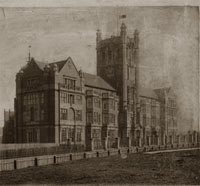
A Schultz-plate (silver halide) photograph of the Merit Ptah Academy, dated mid-19th century.
Merit Ptah was an interesting ancient figure. He founded the first Academy to explore cosmology and its "combinations." He believed that each thing contained an infinite number of infinitely small parts of everything else, and that to change one thing into another was to diminish a larger part to create more of a smaller part.
His favorite example of this cosmology was the "man's face for a day" story. It's fairly short, so I'll print it here. A young man wakes in the morning. His face is made of skin. The sun shines on him, and a part of his skin diminishes to create sweat. He goes into the shade of a date tree, and the sweat diminishes to create coolness. He spends the afternoon eating dates from the tree, and the dates diminish to create various parts of him, like vitality (his life energy) and flesh. If he eats too much, he will convert more dates to flesh than he needs, and he will grow fat. If he eats too little, he will not create enough vitality, so he will have to diminish flesh to create vitality, and he will grow thin. By sunset, he leaves the palm. He rubs his chin and feels stubble, for part of his skin has diminished to create hair. The man sleeps, and the story ends.
Merit Ptah asked the students of his academy, "Why does sweat consistently convert into coolness? Why does skin consistently convert into sweat?" And so on and so forth. Their answers were the combinations, the mixtures of greater parts which caused the creation of other things. Heat and skin, for example, caused skin to create sweat. Dryness, coolness, and sweat combined to create coolness. Everything could be explained as a combination of the parts that caused it. Merit Ptah founded his academy in order to list out all the parts, to study their combinations, and to catalog those combinations for their uses.
One of his greatest accomplishments was the invention of aspirin. I'll quote my husband's passage from Our World, in which he quotes Merit Ptah.
Shortly after Merit Ptah's death, aspirin distillation was discovered by an unnamed student. Powdered aspirin would be used by Tsars until the Industrial Era, when a synthetic aspirin formula was developed.Viazmitin Lun posted:
Since our species spread out from Spain, man has put the world in his mouth. In most cases, the results were unpleasant but insignificant. In a few cases, the results were far more interesting.
For example, the first great scientist, Merit Ptah, once sampled the plants along the Moskva River. "The willow's bark," he wrote, "tastes bitter against the tongue but wards against weariness. Combine one handful of bark with boiling water and drink to create relief from one day's pain."
As a combination, aspirin and flesh was especially interesting. It proved that certain combinations were medicinal, and that proof was an incentive. In his later years, Merit Ptah received a vast fortune from the Tsar. It was hoped that he would discover a combination of objects to preserve vitality or revitalize dead material. To this end, the academy labored consistently until the eleventh century AD, when the Duchy's withdrew the wealth of Moscow, and the academy's patrons and vaults ran out. It was abandoned for two decades, until one of its students inherited the Crimean Duchy and the academy was rebuilt. After that, the third renovation, the search for immortality was deemed an alchemically impossible waste of resources, and the academy refocused its efforts on more meaningful alchemistries.
Four hundred years later, Cai Lun stepped into this alchemical environment and changed it one more time.
As a mixed child of Russian and Chinese parents, Cai had difficulty integrating into either Russian or Chinese culture. He ran away from Parthian at the age of twelve and lived as a Tourist for almost a decade. During his travels he learned the Russangxi tongue, and with his linguistic skills and street smarts, he found a place for himself as the apprentice of a small gunpowder miller east of Grozny.
In his spare time, he socialized with many of the miller's visiting clients, including the famous gunsmith, T. M. Shpagin. Shpagin was impressed by Cai's intelligence and offered to show him the new design of the Archimedean grenade. Cai accepted Shpagin's offer and took a holiday in St. Petersburg, where Shpagin introduced him to metallurgy. Near the end of his visit, Cai took an interest in the design of the grenade itself. The original grenade was cast from solid iron in the shape of a hollow ball. Cai drafted a simpler design which could be cast in two halves for a fourth of the original price. These halves could be slotted together and "glued" with molten lead, which was much easier to smelt and pour than iron. The original design was preferred because it was waterproof, but Cai argued that his grenade could be dipped in a hard wax like paraffin, thereby waterproofing and rustproofing it at a much lower cost. His designed and arguments impressed Shpagin, and with Cai's permission, the smith began producing his grenades. Within a year, the military adopted Cai Lun's design for its cost-efficiency, and Shpagin personally delivered the first royalty check to Cai, along with an offer to learn gunsmithing from a master.
Cai declined the offer, but asked Shpagin to write him a letter of recommendation. With the master gunsmith's signature, Cai applied to the Merit Ptah Academy of Alchemy, as it was known to him. His brief lesson in metallurgy had interested him in the unusual properties of combinations and mixtures. At the time, the academy was the only place on the planet which rigorously studied alchemy, and as far as Cai was concerned, it was the only place suitable to learn the science.
The most prestigious faculty member, Dmitri Mendeleev, was a good friend of Shpagin. After an interview at Shpagin's insistence, Mendeleev gladly apprenticed Cai to himself and taught the young man his body of alchemical knowledge. In the preceding decade, Mendeleev had proven that some chemicals couldn't be broken down or distilled. He called those chemicals the elements because they were alchemically fundamental and could not be reduced to anything less than what they were. While studying Mendeleev's notes, Cai realized that two of the most volatile elements, lithium and sodium, had similar properties. With Mendeleev's permission and assistance, he scoured the records at the academy and assembled his thesis work, Elemental Properties, which pointed out that most of the known elements could be classified into families with similar properties. He theorized that as more elements were discovered, they also would fit into these families.
Nearly two centuries later, the German scientist Julius Lothar Meyer would take inspiration from Cai Lun's thesis and craft the theory of elemental periodicity, otherwise known as the table of periodic elements.
With the close of the Three Year War, the production and the royalties for grenades dwindled. On the edge of complete poverty, the academy granted him an unusually young chair in the faculty, and in between lectures, Cai Lun studied explosives as a class. During this time, he invented dynamite, for which he became famous, and the shotgun, for which Shpagin famously thanked him with a "feast of one thousand geese."
But Cai's lasting contribution, the invention which I believe made him a great man, began as a small argument in the last pages of Elemental Properties. Cai Lun speculated that all chemicals were complex material combinations of elements; more specifically, he argued that no chemicals were fundamental themselves, and that furthermore, no chemical contained the essences of non-elemental substances such as love, justice, or temperature. Essentially, he explicitly denied the alchemical theory that the entire cosmos was made of combinations. He narrowed the realm of chemistry down to the realm of material things: gases, liquids, solids, and "flames."
It was the study of "flames" that opened the academy to Cai's point of view. In 1511, one of Cai's students ignited the main hall, and it burned to the ground. By then, Cai's dynamite had made him a rich man, so he bought the blasted property and paid to renovate it. Since the funding was almost entirely his, he gained wide influence amongst the faculty and became something of a tyrant. He turned his speculation into law and discouraged what he saw as the fruitless study of alchemical effects (transmutation, creation of emotion, immortality, etc.)
"Only chemistry," he wrote in his journal, "is worthy of my academy." In time, his followers would agree that he made the right decision. He shed chemistry of its mystical elements, leaving behind the seed that would sprout into the industrial science.
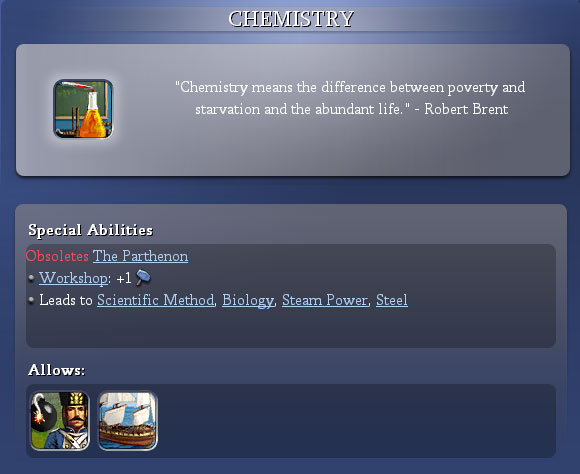
Bacon's Denaturalist Academy - Banking and EconomicsAside posted:
Chemistry is a fecking awesome technology. It represents a blend-point between two eras. Before gunpowder, war is mostly offensive. Pound for pound, unless you're playing Civ4:Warlords with a protective leader, it's more efficient to spend production on siege units, city attackers, and mounted units, than it is to make defenders. Of course, you should try to give every city two defenders if possible, since this boosts your power rating and makes your empire easier to defend against a sudden invasion. But during war or during a buildup, you're better off buying attackers than defenders.
Chemistry gives you a bizarre mixed unit, the grenadier. It is a very powerful attacker, but it can't naturally take the city attack promotion. To have the city attack promotion, your grenadier must be upgraded from an existing city attack unit. Instead, the grenadier naturally promotes like a city defense unit. It can take the city defense promotion and recon promotions like guerrilla and woodsman.
Hence, grenades are also a powerful defender. And since grenades are lower on the tech tree than riflemen and cavalry, you can have them up and defending long before the bigger, nastier gunpowder units come tumbling out of enemy production cities.
Also, as riflemen are spawned to defend cities, you can use grenadiers and their huge anti-rifleman bonus to take down the best defender of the era as well.
Lastly, as a technology, chemistry opens up the scientific method and biology, both of which are amazing technologies. After I finish this update and the next, I'll begin on the industrial era, in which I'll use biology's superior farms to create a massive production boost in my production cities. Oh, that'll be fun. :]
And of course, if you've been fighting a sea war, the frigate is a badass fighting machine. Just be well aware that while it is good for blowing up and defending galleons, ironclads are only one more tech up the tree, and defensively, a handful of those slow bastards can totally fuck up your assaulting fleets.
As you can imagine, I chose Chemistry as soon as possible because I wanted a kickass unit to whip the living shit out of Spain's stupidly large medieval army. I still don't know how four cities produced so many fucking units.
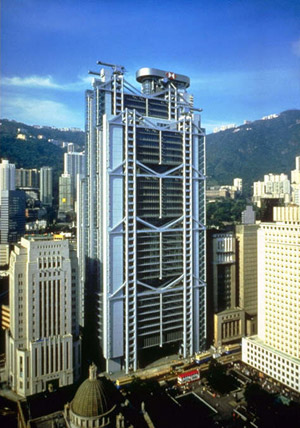
The modern building for the BEI (Bacon Economic Institute).
"Widespread education. Passion for the state. Rational control of will." These are the words on the plaque in front of the BEI building in Shanghai. But long before it became a government entity and a center for the regulation of the World State's economy, this was a struggling Denaturalist academy in the middle of a foreign culture.
At the start of the 13th century, the founder of Denaturation, Francis Bacon, traveled to the newly conquered province of Shanghai to found a school of philosophy. During the remainder of his life, the academy showed promise and signs of success thanks to the patronage of Duke Gaafa VII, the son of the conqueror of Shanghai. Unfortunately, shortly after Bacon's death, Duke Gaafa VII passed the estate onto his son, Gaafa VIII, who was half-Chinese. His mother, a Chinese princess, was a subversive nationalist, and she taught Gaafa VIII to hate the Empire and its ideological supporters. Incompetent but tyrannical, Gaafa picked the academy as an easy target and withdrew his estate's funding, and within two decades, the academy's building was abandoned and sold due to disrepair. After that, Bacon's followers met in his former home on the edge of Shanghai, where they dutifully studied Denaturation and waited for the end of the Russo-Chinese war.
In the 1360s, after the conquest of Parthian and the death of the regent, several thousand Moscovian Denaturalists moved into the Chinese provinces in order to escape the crushing liberal influence of the Old Empire. As a group, they sought to introduce Denaturation into the recovering Chinese culture and assure a Denaturalist future for the Russian people. To this end, they formed schools of practical arts whose ideological underpinnings were Denaturalist. In Shanghai, a merchant, Dan Nyetemko took an interest in Bacon's old school. He bought the original property (which had become a hotel) and reopened the academy. Though his ultimate motive was to teach Denaturation and build nationalist fervor, his school's surface goal was to teach mercantilism and the art of loanmaking.
The specific method of Nyetemko's economics can be summarized in one line: "Maintain a positive balance of trade." In other words, make sure that more goods go out than come in, and more money will come in than goes out. This is the heart of mercantilism, and Nyetemko taught many techniques to create favorable conditions. One of his favorites, a technique he personally taught to apprenticed students, was banking--a financial system he borrowed from his Jewish ancestors.
Nyetemko didn't invent banking, you must understand. He simply organized a way to teach the system, and he created standard banking terminology. He called it fractional-reserve banking, because the reserve of gold bullion was always a fraction of issued notes.
To put it in real life terms, Nyetemko was a clever goldsmith. He took rubles and kopeks, which at the time were physical coins containing a certain amount of bullion, and he exchanged them for promissory notes. These notes were a kind of safekeeping--a person could store all their gold in Nyetemko's secure estate, and using the promissory notes, they could pay for goods and services. If a person ever wanted their coins back, they could take the notes to Nyetemko, and he'd exchange them again.
Nyetemko's ancestors had eventually realized that nobody ever exchanged all their promissory notes at once. If they needed solid coins, the customers almost always asked for as few coins as possible. Given a large supply of bullion, Nyetemko could safely issue promissory notes for coins that he didn't have. It was extremely unlikely that anyone would demand to exchange notes for coins that he couldn't hand over. Therefore, he could issue promissory notes as loans with interest, based on the assumption that those notes would repaid by the debtor. Eventually, as the loans were repaid, fresh bullion would flow into his reserve, and he could issue even more loans. As you can see, the reserve--the money he had on hand--was a fraction of the money he credited--the notes that he loaned out. Unless there was a bank run, when everyone came to exchange their notes all at once, Nyetemko made an incredible profit off of the payments for the unbacked loans.
Isn't that a complicated subject? But that is what Dan Nyetemko taught to his students, and that is why he is called the father of the modern banking system.
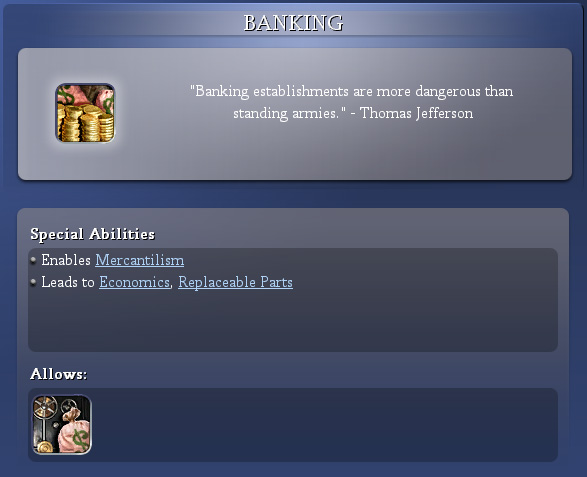
By the Final Period of the Great Renaissance, Nyetemko's material and Bacon's school had educated a whole class of wealthy Russangxi Denaturalists, most of whom are considered responsible for the First Cultural Revolution and the start of the Industrial Era. One of these men is of particular interest, Hanno the Navigator. In the interest of bringing mercantilism the prestige of sciences like chemistry, he left Shanghai and traveled to Port Novgorod, whereupon he sailed with a trading barge along the Antarctic Sea until he reached the Tethys Ocean and Dortmund city beneath Sunset Peak. During this journey, he accounted for the quartermaster in exchange for full access to their books for the past decade. Eventually, his access to the ledgers and his experience with actual trade along the international coast led him to develop a theory of national wealth. He published a book, Of Riches and Nations, which was a scathing critique of mercantilism.Aside posted:
Banking is an offbeat tech. In some games, you will be very happy to reach this point. In others, you'll leave it alone because you simply don't need mercantilism, and you won't need banking until you want Economics.
I chose Banking immediately after Chemistry because I *really* needed mercantilism. I've warred so much in this game that I don't earn much from cross-civilization trade. It's better for me if I take the mercantilism civic and begin to rebuild my empire's ailing economy.
Remember when I said I was down to 50% science/50% gold and still in the red? When I nabbed Banking, I was granted access to mercantilism. Mercantilism turns off foreign trade routes and gives you a free specialist in every city. Remember specialists? They are population points which do not work city plots and give you research, production, culture and/or gold. If you get a free one, it's like having another population point that you don't have to feed, and it's producing whatever you need!
Since my empire is so large and my friends are so few, I swapped to mercantilism and only lost a handful of points of commerce. In exchange, I gained a vast number of free specialists, most of which I set to become merchants. Back in the medieval era, I started building grocers. Grocers allow one merchant specialist to be set in a city. Since all my cities had grocers, I was able to set almost all of my free specialists to merchants. Each merchant gives me 3 gold. With nearly two dozen cities, that's 72 gold!
By switching to mercantilism, I went from -14 gold per turn at 50% science to +36 gold per turn at 60% science. Because my empire is so large, that 10% science translates into a massive research boost.
Oh yea, and Banking leads to two other great technologies. Economics gives a free great merchant to the first researcher and opens up the ludicrously powerful Free Market civic. Economics leads to Corporations, which gives your cities +1 trade routes (another huge research and commerce boost).
Plus, once you've researched banking, you can make banks. Banks give +50% gold output from a city, which makes them a critical building, and they are a pre-req for the Wall Street national wonder, which gives +100% gold output to one city. Essentially, Banking is the start of a three tech run that will change your empire from running on small savings to producing a vast amount of spare gold for gold-rushing, buying diplomacy, and upgrading military units.
Who's rolling in the money? That' right.
He argued that national wealth was generated by the competitive trade of resources in a free market. Enforcing protectionist tariffs, a common mercantilist practice, simply handed the reigns of the economy over to a local monopoly or special interest, and special interests had no motivation to generate wealth for anyone but themselves. Furthermore, he derided the hoarding of gold bullion as a mistake. Gold was not an intrinsically valuable resource, and its scarcity only mattered as long as people assumed that everyone else was interested in acquiring it. Real resources, on the other hand--like textiles, food, fuel, chemicals and industrial metals--were always in demand and had a real value. To increase the overall value, a capitalist simply mobilized resources for application in exchange for another mobilized resource. For example, a nation might export surplus grain in exchange for another nation's surplus iron, and both nations would benefit by giving away what they don't need in exchange for what they can use. In Hanno's opinion, such trades would only occur in free markets untouched by government intervention and protectionist taxation.
Though Hanno's ideas wouldn't be implemented for centuries, his book gave economics a rigorous philisophical foundation, from which modern economics and the BEI would grow.
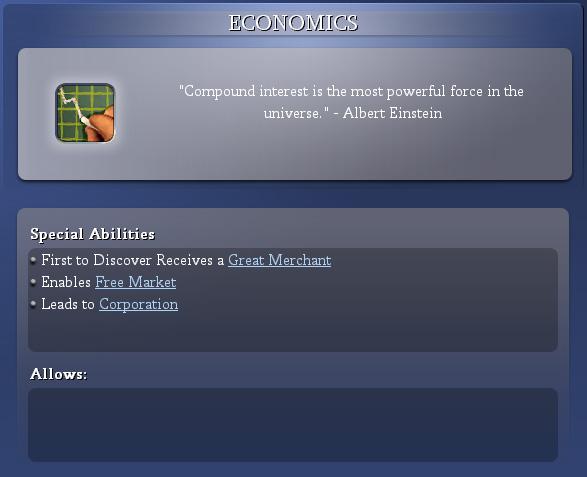
Ptolemy's Academy - SteelAside posted:
Economics is the second part of the three-set of powerhouse fiscal technologies. After Banking, you can pick up Economics for a free great merchant (worth an assload of cash), the Free Market civic, and the open choice for Corporation.
If I haven't done so already, let me describe Great Merchants. They have the ability to barter a one time business deal with any foreign city. The further away and the larger the city, the bigger the deal. For some people, it's a powerful strategy to pop great merchants and take the massive infusions of income as soon as possible. Why? Most people who speed dominate or speed conquest are running out of money very fast, and they need fresh income on a turn by turn basis. Golden Ages and Great Merchants supply much of the cash. Other people simply want to tweak up the tech slider to 100%, which will generally speed their midgame and lategame research to ludicrous fast.
Plus, money is really rare until the Industrial era. For this reason, popping a great merchant in the early or mid-game can put you very, very far ahead of the pack.
Oh, and don't let me forget to describe Free Market. For a middling support cost, you get a civic that gives all your cities an extra trade route. If you've got good friends and a middle-sized empire, this makes Free Market the best civic in the entire economic line. If you've got a very large empire, mercantilism or state property becomes a better choice, depending on your playstyle.
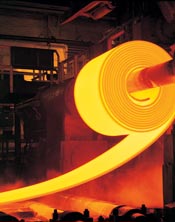
A glowing-hot roll of pressed titanium-steel, produced at the Ptolemy Industrial Research Facility in Delhi. Workers have to wear protective gear while in the room with the steel, as the air temperature rises to over 300 degrees Celsius within five meters of the "cooling" roll.
The future of industrial warfare began with Francisco de Quevedo, smith of the Steel Dadao. He died during a robbery almost four and a half centuries before the Three Year War. His possessions were carried to Barcelona, where his smith's lockbox, still unopened, was sold to an Egyptian river-merchant. The merchant broke the lock while sailing upriver towards Memphis, ruffled through the contents, and supposedly discarded most of them except for a couple of ivory-hilted knives and the lockbox's key, which Quevedo had locked inside it. He tied the key to a necklace, which he wore until his death in the 1021 fire that nearly destroyed Memphis. It stayed buried in the scorched ruins of the river-slums until 1111, when a renovation project discovered the key, completely unharmed by fire, age or the elements. The taskmaster mentioned the key in his daily report, and its description came to the attention of the governor's son. He purchased the key and placed it in the governor's collection. During this period, the key was mostly ignored, and all records of it vanished until 1423, when an Egyptian diplomat gifted the key to a Russian metallurgist named Bessemer. Bessemer returned to Moscow, where he studied the key for a while and remarked on its unusual properties. He then sent it to the Ptolemy Academy of Engineering, where it was collected, tagged, and set aside in their archives for nearly two decades. In 1441, a student of the academy, Kelm Pradzi, rediscovered the key and compared it to the academy's collected metallurgical texts. He discovered several references to a coal-iron alloy (pig iron) which nearly matched the properties of the key--nearly, mind you, since the key wasn't brittle. However, the key matched the descriptions of steel (from writings on the Steel Dadao), and he surmised that it must be another fragment of the unique metal.
In one of history's strange paths, a sample of high-quality steel had reached a Russian engineer. Since pig iron had an extremely high melting point, Pradzi assumed that steel must have a melting point in a similar range. The academy had bought a Siemens regenerative furnace--a furnace using its exhaust heat to preheat the fuel in order to speed combustion and raise the temperature--and utilizing this furnace, Pradzi melted the key and poured out a thin film that could be chemically tested. In the acid wash, it broke down as an iron-nickel alloy with a small carbon impurity, implying that it was a kind of low-carbon pig iron.
The materials in pig iron were well documented. Pradzi wondered, was it possible to create steel by removing carbon, manganese, tin, and silicon from pig iron ingots? With the help of a master metallurgist, Dmitri Leskov, he ran several tests with half-ton pig iron samples. The Siemen's furnace was capable of cooking up to ten tons at a time, and theoretically the furnace could be made much larger, but practical fuel concerns restricted the size of it. There simply wasn't enough wood to run a larger furnace for weeks on end.
Eventually, after two years, they managed to produce low grade wrought iron. While not a true stainless steel, like the Steel Dadao, this iron was of superior quality to the cast bronze that had dominated the metal casting process for centuries. Furthermore, initial tests indicated that it had a higher tensile strength than bronze and would make for a better gun barrel.
From there, it only took the aid of Cai Lun to develop new weapons. Leskov contacted Shpagin with news of the new metal product, Shpagin contacted Cai Lun, and Cai spent a summer at Grozny helping Shpagin work out the theoretical limits of proto-steel. Cannons started as a joke, but as the weeks passed, Shpagin began to seriously consider the production of human-sized guns with bullets the size of skulls. Just before returning to Moscow, Cai calculated that wrought iron was more than strong enough to handle the cannon's powder charge, and though he never saw Shpagin fire the first prototype, Cai is partially credited with the invention of the cannon because of his invaluable help.
Though steel technology was far from complete; though there were advances to be made after the discovery of coal; the Russians had successfully developed a kind of steel and applied it as a weapon of war.
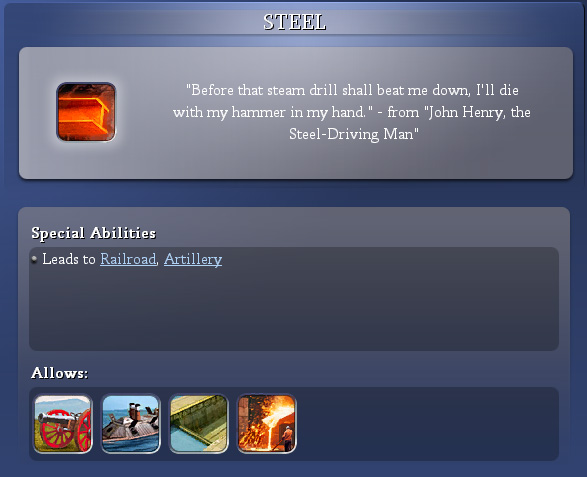
Aryabhata's Academy - AstronomyAside posted:
Here is the weapon that won me the war. Steel is a great technology, and it was the tech that nudged me into the Industrial Era. Cannons are brutally powerful. They're as strong as grenadiers (strength 12), they can bombard away defenses in a handful of turns, they can take the city raider upgrade, and they deal collateral damage to multiple targets. Once you go through grenadiers, it's generally a good idea to rush for cannons or cavalry, and in this game, I chose cannons.
As you notice, Steel also gives you access to ironclads (the last word in naval defense until modern navies), dry docks (crucial buildings on water maps, since they give ships free experience), and the ironworks national wonder (an extremely expensive building that gives up to +100% production in one city depending on the availability of certain resources. The Ironworks will turn one city into a production powerhouse of unimaginable speed. I will build one in St. Petersburg.
What comes next? Railroads are a fantastic choice, but there are a lot of Renaissance techs I need to finish collecting before I dig into the meat of the Industrial Era.
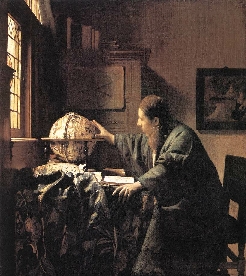
An oil-on-canvas of the Great Renaissance astronomer Mikhail Lyapunov in his study.
In the latter half of the Changing Century, lens grinding techniques quickly reached a plateau that wouldn't be bested until the advent of electrical power tools. Mirror polishing techniques followed a similar pattern, and by the late 1350s, the science of telescopy matured. Telescopy, the design and application of telescopes, was of great use to both sailors and astronomers, both of whose naked eyes had limited their options for millenia.
At Aryabhata's Academy for Cosmological Science, mathematics and astronomy had followed a long and tedious dance towards a proof for heliocentrism and the identity of the stars as distant suns. Furthermore, though several of the planets had been discovered and identified since ancient times, the exact nature of the planets was an intractable problem. Telescopy eventually provided experimental solutions.
To the problems of the planets, mirror telescopes helped astronomers discover that Mars and Venus were terrestrial bodies, one covered in a single continent of red dust, and the other swathed in eternal clouds. Jeremiah Horrocks, a Jewish astronomer, wrote in his journal:
In the late 1470s, Mikhail Lyapunov used Horrock's records and Kepler's Laws to calculate the orbital mechanics of Venus [i]if[/] it were part of a heliocentric system. Surprisingly, he discovered that the planet Venus was due to pass in front of the sun in 1522, during the midsummer. He couldn't refine the date any further without assistance, so he took his calculations to the head of the academy and was assigned a team of observers to help him. If he could observe a daylight transit of Venus across the sun, he could simultaneously verify the heliocentric model while filling in many of the unknowns, such as the size of Venus, the size of the planetary orbits, and the size of the sun.Jeremiah Horrocks posted:
In the summer evening, I turned our largest telescope against Venus, the roving eye, and I saw a pale disc, almost white, like a world wrapped in an endless fog or cloud.
What lies beneath that obscuring cotton sea? Is there some shadowed rainforest filled with birds and beasts? Or maybe a barren and glassy desert endlessly lanced by dry thunderstorms? Could something intelligent live there, looking up at the clouds, and wondering if someone was beyond the roof of the world looking back?
Maybe it is just fantasy, but if this world is covered in life and souls, why wouldn't any other celestial body grow green and be filled with G-d's creatures?
On December 26th, 1522, the transit occurred around 3PM in the afternoon. He made a measurement in Bombay, while further north, in Parthian, another measurement was made by a colleague. He placed a simple mirror telescope in a darkened room, opened a shutter to allow the telescope to see the sun, and cast the image of the sun through the scope onto a sheet of white vellum. He then watched Venus pass in front of the sun as a black dot, whose relative width, motion, and velocity he could measure.
In short order, the heliocentric model was verified and the scale of the solar system was calculated. The movement of the Earth and the movement of Venus were compared against the sun as a motionless background, allowing Lyapunov to calculate the parallax of the system. He calculated a distance of 100,000,000 km between the sun and Venus (a very close estimate), and 150,000,000 km between the sun and Earth.
With this refined model of the solar system in hand, the academy rapidly constructed a model of the Earth's orbit. The model's errors can be attributed to the lack of gravitational mechanics, a science which wouldn't exist for many more years. Nevertheless, their new model of the Earth's orbit was accurate enough. They generated starmaps up to a decade in advance. With one of these, you could nagivate the planet with a clock, a calendar, a starmap, and an astrolabe. If you had the date and an accurate clock, you could discover your latitude by taking an astrolabe and measuring the distance between several stars and the horizon. For the corresponding longitude, you simply checked the time on your clock when the sun was at its zenith. Depending on the time on the clock, you could calculate how many degrees east or west you'd sailed across the planetary surface from the region where you originally calibrated the time, generally the meridian at Moscow.
Lyapunov's measurement represented the first great triumph of astronomy, and because of its repercussions in oceanic navigation, he was inducted in the Chapel of Heroes for making the first societally significant measurement in the modern astronomical tradition.
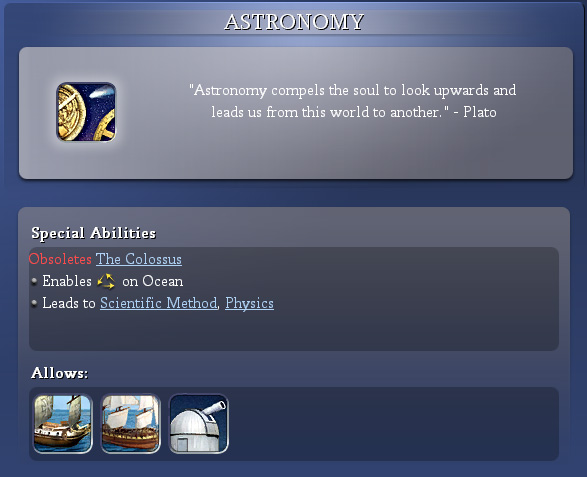
Towards An Industrial FutureAside posted:
Woot! Astronomy is a big technology. Note that I researched it *after* the technologies I list below this update.
You can't skip Astronomy. Not only does it make colonization of other continents possible, but it links anything on the coast to anything else on the coast, anywhere in the world. Trade routes are now possible to almost anywhere. Furthermore, it is the pre-req for Physics, and without Physics, the modern technologies are essentially unavailable to you.
It unlocks the Galleon, a powerful carrier unit (strength 4, 3 spots in the hold). It also unlocks, with Chemistry, the Frigate, the fighting ship of the Renaissance. Both of these ships can cross the ocean, making them crucial for players on Terra maps, island maps, and players launching early cross-oceanic colonies or conquests. In fact, if I were so inclined, I could conquer the English continent with these ships. But I won't, because I'm not so inclined. :]
Lastly, Astronomy unlocks the observatory. Until the Lab appears in the late game, the observatory is one of the last research boosting buildings, and it's well worth putting one in every major science city. For that reason, I suggest getting Astronomy sooner than later. Research-techs build faster research, you know?
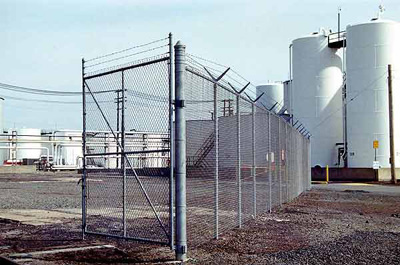
How can I tie these various elements together? In this image, I have a picture of an oil refinery and a natural gas plant. I walked past it when I was fourteen and wrapped my fingers in the chain-link fence. I stood in awe of what humanity built. Every metal surface was painted whiter than a flower; each cooling tower glistened icily in the midmorning sun. Twisted power lines, fat like pipes of licorice candy, were laced over enduring poles. I remember Viaz putting his arms around me, like a guardian. He felt the place was desolate, but I saw it as something beautiful, a monument to human magnificence. The species was at work here, and at that moment, I felt proud of what we'd done.
I hope that this article has given you the same sensation, the same pride for what we've built. Modern civilization rests like a delicate crown upon the world-weary brow of an ancient and indestructible king, the industrial technology whose youth and frailty was left behind in the Final Period of the Great Renaissance.
---END UPDATE---
Divine RightAside posted:
I want to briefly list the other technologies I researched. I will describe these in narrative in the final update to this time period, after which I will resume playing the game in the Industrial Era.
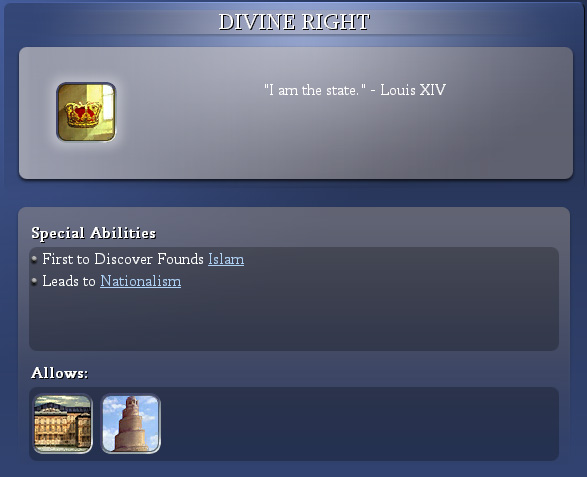
NationalismAside posted:
Divine Right is essentially the last of the religion techs, and if you've been holding off on religious techs, it's easy to pick this one up and spread Islam in the mid-game to make back some cash.
I picked it up at this stage in the game because it is the pre-req for Nationalism, which is an important tech and definitely worth my time. If you hit Divine Right early, it is a strong tech. The Spiral Minaret makes all state religion buildings money-machines, and the Versailles is a world wonder that can act as a second or third center of government in your empire. Like the Palace in your capital and the Forbidden Palace in your secondary city, Versailles severely reduces maintenance costs in nearby cities.
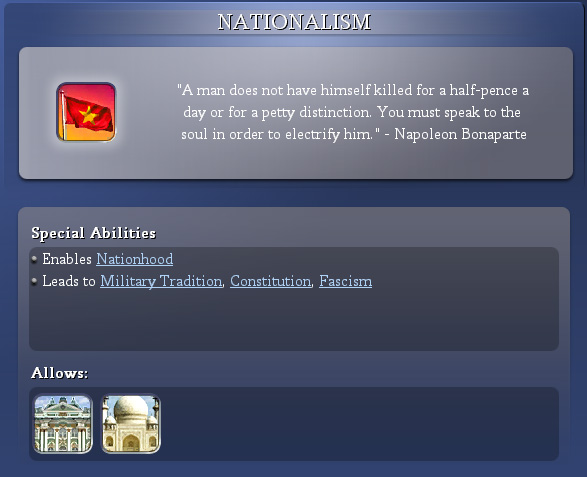
ConstitutionAside posted:
Nationalism is a cool technology. It isn't optimal, but damn, it's really fun to mess with. It unlocks a mediocre world wonder, the Taj Mahal, which starts a Golden Age in your civilization. It also unlocks the Hermitage, a forgettable national wonder that gives a city +100% culture. It's great if you're heading for a cultural victory or if you're playing a peaceful game. Otherwise, it's mostly worthless.
More importantly, Nationalism unlocks the Nationhood civic. This allows you to draft 3 inexperienced "core" units per turn from the populations of your cities. Plus, it causes cities with barracks to become happier by +2, so that the draft anger equals out to a paltry -1. You might think, so what? Well, if you have a real good GP farm with a Globe Theater, then you can draft a new unit almost every turn for the rest of the game. If you've got several good farm cities, you can draft three new units every three or four turns, even in poor production conditions. In some builds, like the ICS empires, nationhood is an extremely good civic.
Oh yea, and Nationalism is a pre-req for military tradition, constitution, and fascism. This is important, because Military Tradition kicks serious ass. It unlocks rifle cavalry.
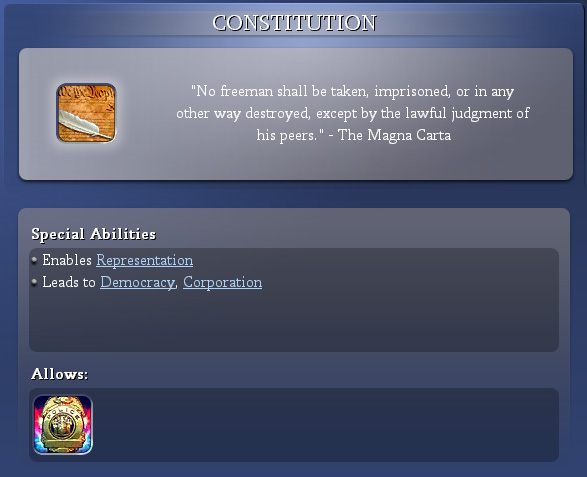
So far...Aside posted:
Constitution is the followup to Nationalism. It gives you jails, which are mediocre buildings, only useful if you're in a drawn out war or if you're playing Civ4:Warlords as the Indians.
More importantly, Constitution unlocks the Representation civic. Generally, people attempt to acquire this civic by building the Pyramids in the early game. But even if they have to wait, many people who run specialist heavy civilizations utilize Representation. It is essentially a +3 research to every scientist, and +3 happiness to the five largest cities in your empire. That makes for a huge boost in early-game empires and a fairly good boost in the midgame.
I teched to this because I wanted access to Democracy and Corporation, both of which are much better technologies.
I'm glad I wrote another update. I'm sorry this took so long from the last bump, but I reread the thread, played several games of Warlords, and did a lot of research before I crafted this post.
There is a lot of detail in this one, so if these kinds of facts don't interest you, I apologize. Otherwise, enjoy!
See you again with the next update.

Edit: Fixed a handful of awkward constructions and paragraphs! Huray gud Englash!
